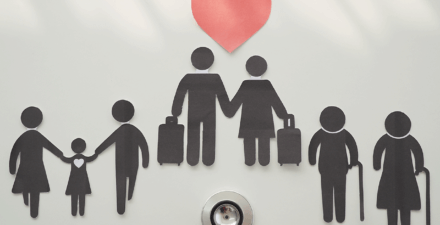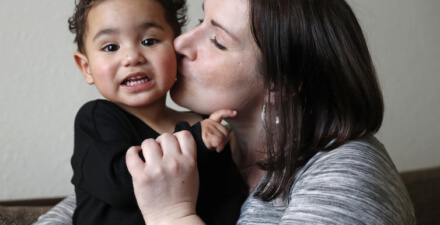For Father’s Day: Evidence from three countries on the importance of paid parental leave for new dads

As we celebrate Father’s Day this weekend, in California, Rhode Island, and other states with operating paid leave policies, you may find fathers taking time away from the construction sites, office desks, restaurant kitchens, and hospital rooms where they are employed. They may be spending time caring for their new children—with pay. Sadly, many new fathers elsewhere in the United States do not have access to guaranteed paid leave to care for a new child. But evidence from recent studies conducted in three different countries—Sweden, Denmark, and Canada—shows that a paternal set-aside in paid parental leave programs can be beneficial for both fathers and mothers.
Paid parental leave—the ability of new parents to take paid time off from work after the birth or adoption of a child—is one of the fundamental benefits a society provides to workers to help them balance the challenges of work with the responsibilities and joys of parenthood. The United States, unfortunately, has no such federal program, although several states have begun to implement their own paid leave programs, and some 2020 presidential candidates have begun incorporating a national paid leave program into their campaign platforms.
Workers across the United States who are able to access leave rely on a patchwork of unpaid leave, employer-provided paid leave, or paid leave from state programs. Across these programs, the vast majority of parental leave is taken by mothers, in much the same way that women do a disproportionate amount of home work—both parenting and housework. According to Equitable Growth grantee Joan C. Williams of the University of California, Hastings College of Law, men “face as many struggles [as women] when it comes to using flexible work policies—if not more—because childcare, fairly or unfairly, is still seen as being a feminine role.”
But there is considerable evidence that greater involvement in parenting by fathers benefits child development and heightens fathers’ short- and long-term engagement with their children, among other upsides. Most developed countries have national paid leave programs, with varying parameters and revenue sources, and a number of countries are zeroing in on caretaking by dads and revising their programs to designate a portion of the benefit specifically for fathers—what some experts refer to as the “daddy quota.” The purpose of setting aside time for fathers specifically is to encourage them to take leave by ensuring that their taking time does not take paid leave away from mothers—mothers are not allowed to use these weeks—and to make clear that fathers taking time is seen as a societal good.
In 2012, for example, Sweden adopted a reform of its existing paid parental leave policy that effectively made it easier for fathers to take leave. Prior to this change, Sweden provided a total of 16 months of paid parental leave, but only permitted one parent to stay at home at a time, other than the first 10 days following the birth of a child, when both parents were allowed to be home together. The reform added flexibility by granting 30 days during which both parents could take paid leave, with the timing up to the parents and no requirement that the days be consecutive. Since mothers overwhelmingly were the individual parent who was at home, it is fair to assume that these 30 days of joint time effectively were additional time for fathers.
In their 2019 paper titled “When Dad Can Stay Home: Fathers’ Workplace Flexibility and Maternal Health,” Petra Persson and Equitable Growth grantee Maya Rossin-Slater, both of Stanford University, used this change as a way of determining what impact paternal leave-taking can have on mothers’ postpartum physical and mental health. Using Sweden’s administrative data, the authors compared the use and timing of fathers’ days off with mothers’ encounters with the healthcare system, and found that fathers’ leave-taking had a significant association with mothers’ reduced medical visits for childbirth-related complications, reduced prescriptions for antibiotics in the first six months post-childbirth, and reduced prescriptions for anti-anxiety drugs in the first six months after childbirth, particularly in the first three months.
Persson and Rossin-Slater write that the results suggest that simultaneous leave allows fathers to stay home and care for infants while mothers get the medical care they need, and that it reduces health complications that require medical visits. They write that even though fathers may only take a small amount of additional leave, the simultaneous-leave reform contributed in meaningful ways to mothers’ postpartum health by enabling mothers to get care when they need it, to get preventive care, or even just to get additional hours of sleep.
Benefits of paid paternal leave were also seen in Denmark after various changes were made to the Danish parental leave program between 1989 and 2002. In a 2018 paper, “Paternity Leave and the Motherhood Penalty: New Causal Evidence,” Signe Hald Andersen of the Rockwool Foundation Research Unit studied whether incentivizing fathers to take paid parental leave affects gender pay disparities within homes—in other words, does it encourage mothers to work more and have greater earnings and stronger careers, and does it have the opposite effect on fathers? Andersen suggests that childbirth drives the household gender wage gap—that there is a “motherhood penalty,” in which mothers suffer for their time away from the workforce and their need or desire for flexible or fewer work hours, while fathers experience a so-called fatherhood premium and tend to be more successful in terms of earnings and careers than nonfathers.
In order to determine if paternal leave reduces gender pay disparities from childbirth, Andersen studied various changes to the Danish paid leave program, including increasing and then decreasing the existing “daddy quota,” as well as compensation changes that increased incentives to take paid leave, which benefitted fathers more since they tended to earn more, among other reforms. Andersen concludes that Danish fathers nearly doubled their average leave time, from eight weeks to 15 weeks, and found that the overall impact on family wages, as well as on narrowing the within-household wage gap, is positive, mainly due to increases in mothers’ wages.
Likewise, a recent study of the Quebec Parental Insurance Program, or QPIP, not only finds significant impacts on paternal leave-taking, but also uses time diaries to explore whether fathers’ leave-taking has an equalizing effect on gender roles inside the home and in work outside the home. “Reserving Time for Daddy: the Consequences of Fathers’ Quotas,” a 2018 paper by Ankita Patnaik of Mathematica, looks at Quebec’s 2006 decision to leave Canada’s national family leave program, which is housed in the country’s Employment Insurance program, and establish the QPIP, the only provincial-level family leave program in the country.
The nationwide EI program offers maternity benefits in the weeks immediately following the birth of a child, plus parental benefits to be shared, however a couple decides, between mothers and fathers. QPIP goes a few significant steps further, providing greater flexibility by permitting parents to take their overall financial benefit in a shorter period of time, imposing less stringent eligibility criteria, and providing more generous compensation by replacing a larger percentage of lost income. Finally, and crucially, QPIP includes a paternal set-aside: five weeks of leave for the father that cannot be transferred to the mother.
Patnaik found that fathers responded in fairly dramatic fashion to the offer of paid paternity leave. Additional compensation was certainly a factor, but interestingly, dads also seemed to be responding to the fact that the leave was directed specifically at them. Even in families where the two parents had not been taking their full allotment of nongender-specific leave, men still increased their leave in response to the new program. Indeed, the average father took exactly five additional weeks of leave.
Patnaik also discovered that QPIP contributed to greater equality in and out of the home. Mothers spent more time in paid work and physically in the workplace, and were more likely to be employed full time. Both fathers and, to a lesser extent, mothers increased the number of hours they contributed to responsibilities at home, with mothers spending more of this additional time with their children and fathers primarily using the additional time for housework. Patnaik concludes that paternity leave can contribute to more equitable distribution of household duties, additional time for women in the workplace, and greater time spent with children. “Paternity leave,” she writes, “may present us with a rare win-win scenario.”
These new studies, and other evidence from countries around the world and from the states with paid leave programs, suggest that establishing a federal program in the United States to provide paid parental, caregiving, and personal medical leave would benefit workers, families, businesses, and the economy.
So, this Father’s Day, as we celebrate the fathers and father-figures in our lives, those who are lucky enough to be on parental leave can be grateful not only for the time they are spending with their new children, but also for the other benefits this leave brings to them and their families. The evidence clearly shows that paid leave policies can increase caregiving by dads, reduce gender pay disparities, and benefit society as a whole in the process.







